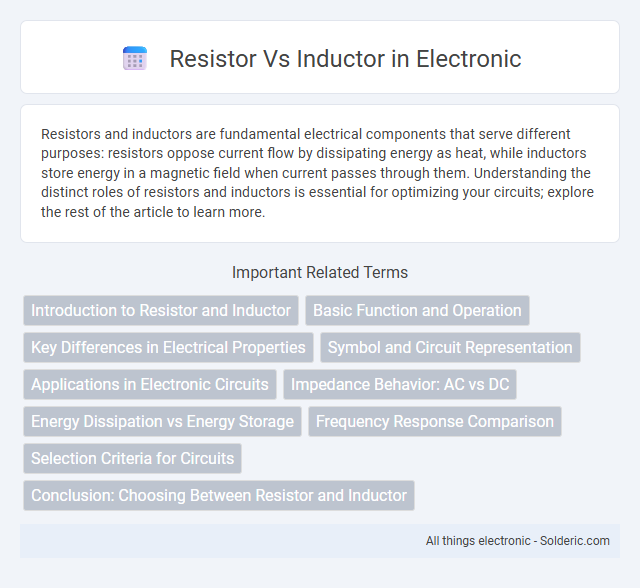Resistors and inductors are fundamental electrical components that serve different purposes: resistors oppose current flow by dissipating energy as heat, while inductors store energy in a magnetic field when current passes through them. Understanding the distinct roles of resistors and inductors is essential for optimizing your circuits; explore the rest of the article to learn more.
Comparison Table
| Feature | Resistor | Inductor |
|---|---|---|
| Function | Limits electric current, dissipates energy as heat | Stores energy in magnetic field, opposes changes in current |
| Symbol | -- (zigzag line) | Coil symbol |
| Unit | Ohm (O) | Henry (H) |
| Behavior in DC Circuit | Constant resistance, allows steady current | Acts as short circuit after initial transient |
| Behavior in AC Circuit | Resists current based on resistance value | Opposes AC current with inductive reactance (XL = 2pfL) |
| Energy Storage | No energy storage | Stores energy in magnetic field |
| Common Uses | Voltage divider, current limiting, heat generation | Filters, transformers, energy storage, chokes |
Introduction to Resistor and Inductor
Resistors and inductors are fundamental passive electrical components used in circuits to control current and voltage. A resistor opposes the flow of electric current by providing constant resistance, converting electrical energy into heat, while an inductor stores energy in a magnetic field when current passes through it, affecting the circuit's voltage and current over time. Understanding your circuit's requirements helps determine whether a resistor's fixed opposition or an inductor's energy storage is more suitable for your application.
Basic Function and Operation
A resistor primarily limits electric current by converting electrical energy into heat through resistive elements, maintaining a constant resistance regardless of frequency. An inductor stores energy in a magnetic field generated by current flowing through its coil, opposing changes in current with inductive reactance that varies with frequency. While resistors dissipate power, inductors temporarily store and release energy, resulting in different behaviors in AC and DC circuits.
Key Differences in Electrical Properties
Resistors oppose electric current by converting electrical energy into heat, exhibiting a constant resistance regardless of frequency. Inductors store energy in a magnetic field when current flows through them, causing impedance that increases with frequency due to inductive reactance. Unlike resistors, inductors introduce phase shifts by causing voltage to lead current, which is crucial in AC circuit behavior and signal filtering.
Symbol and Circuit Representation
The resistor symbol is a zigzag line or a rectangle representing its opposition to current flow, shown in series or parallel configurations within circuit diagrams. The inductor symbol consists of a series of curved loops or coils, illustrating its ability to store energy in a magnetic field, often depicted with terminals connected to other components. Circuit representation clearly distinguishes resistors by their linear resistance property, while inductors are identified by their inductance and reactance characteristics.
Applications in Electronic Circuits
Resistors are essential in electronic circuits for controlling current flow, dividing voltage, and setting bias points in amplifiers and digital logic circuits. Inductors are widely used in filtering applications, energy storage in switching power supplies, and in tuning circuits for radio frequency signals. Both components play critical roles in signal conditioning, noise reduction, and frequency response shaping within various electronic devices.
Impedance Behavior: AC vs DC
Resistors maintain a constant impedance under both AC and DC conditions, allowing current to flow proportionally to the applied voltage. Inductors exhibit low impedance at DC due to steady current but present increasing impedance to AC as frequency rises, caused by their property to oppose changes in current. Understanding this frequency-dependent impedance behavior helps you design circuits for filtering, tuning, or energy storage applications effectively.
Energy Dissipation vs Energy Storage
Resistors dissipate energy as heat due to the resistance to electric current, following Joule's law, making them essential for controlling current flow and protecting circuits. Inductors store energy in a magnetic field when current passes through their coils, enabling temporary energy storage and release without energy loss. This fundamental difference defines their roles: resistors convert electrical energy into thermal energy, while inductors maintain energy within the circuit through magnetic flux.
Frequency Response Comparison
Resistors exhibit a constant impedance regardless of frequency, maintaining a steady voltage-to-current ratio across the entire frequency spectrum. Inductors show a frequency-dependent impedance that increases linearly with frequency, causing higher opposition to current flow at elevated frequencies. This fundamental difference makes resistors ideal for broadband applications, while inductors are crucial for filtering and tuning circuits where frequency selectivity is required.
Selection Criteria for Circuits
Resistor selection criteria prioritize resistance value, power rating, and tolerance to ensure proper current limiting and voltage division within your circuit. Inductor selection focuses on inductance, current rating, core material, and quality factor (Q) to optimize energy storage and minimize losses in filtering and tuning applications. Understanding these parameters helps you choose the right component for efficiency, stability, and performance in your electronic designs.
Conclusion: Choosing Between Resistor and Inductor
Choosing between a resistor and an inductor depends on your circuit's function and desired behavior; resistors provide constant resistance to current flow, dissipating energy as heat, while inductors store energy in a magnetic field and resist changes in current. For signal filtering or energy storage in power supplies, inductors are ideal, whereas resistors excel in controlling voltage and current levels. Your circuit design requirements, such as frequency response and energy efficiency, will guide the optimal selection between these components.
resistor vs inductor Infographic

 solderic.com
solderic.com